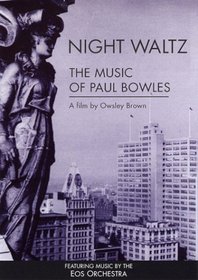| Actor: Paul Bowles Director: Owsley Brown Genres: Documentary Sub-Genres: Documentary Studio: Zeitgeist Films Format: DVD - Black and White,Color DVD Release Date: 09/02/2003 Original Release Date: 01/01/2002 Theatrical Release Date: 01/01/2002 Release Year: 2003 Run Time: 1hr 17min Screens: Black and White,Color Number of Discs: 1 SwapaDVD Credits: 1 Total Copies: 0 Members Wishing: 3 MPAA Rating: NR (Not Rated) Languages: English |
Search - Night Waltz: The Music of Paul Bowles on DVD
  | Night Waltz The Music of Paul Bowles Actor: Paul Bowles Director: Owsley Brown Genres: Documentary NR 2003 1hr 17min An insightful illumination of author Paul Bowles' original and lesser-known career as an avant-garde composer, Owsley Brown's Night Waltz is an elegant and soulful document of discovery. Interviewed in Morocco during the l... more » |
Larger Image |
Movie DetailsSimilar Movies
Similarly Requested DVDs
|
Movie ReviewsExcellent intro to Bowles' music, imaginative filmmaking J. Clark | metro New York City | 10/31/2003 (4 out of 5 stars) "Owsley Brown's documentary Night Waltz (1998) is a revealing introducton to the wide range of Paul Bowles's music, from pieces for solo piano to songs to works for chamber orchestra (the composer eschewed large-scale symphonic works). In addition to extensive interviews with Bowles, the film presents several imaginative visualizations of over a dozen of his pieces, using a variety of approaches, which add an additional layer to hisunique sound world.Two years before his death in 1999, Bowles gladly accepted the offer of first-time filmmaker - and longtime admirer - Owsley Brown to create a documentary about his relatively unknown early career as a composer of avant-garde yet "charming" (Bowles's own word) music. Long after he stopped composing, Bowles kept music as a vital part of his life. It is endearing and moving to see this frail but resilient 87-year-old man constantly tapping out fresh, complex rhythms on his Tangier table top.Brown and Bowles began working together to present the music in a manner which would allow audiences to experience it for themselves, even as the film offers insights into Bowles the composer and to a lesser extent the man: Bowles is notoriously tight-lipped about his private life.Although today Bowles is known primarily as the author of the classic novel The Sheltering Sky, he began his career as a promising - many would say accomplished - composer. At one point, he shares what connects his music and writing, namely, rhythm and simplicity. As he says, "Keep everything simple. Pare it down, and throw everything else out.... I prefer the simple but not minimalist... in my music and writing."During the 1930s and '40s he wrote 200 songs, dozens of pieces for solo piano, a wide range of works for chamber orchestra, the incidential music for two dozen Broadway plays (including the premieres of such classics as Tennessee Williams's The Glass Menagerie and Summer and Smoke, Lillian Hellman's Watch on the Rhine), ballets (Yankee Clipper, Pastorale, Colloque sentimental), a cantata (Par le dètroit), and operas (Denmark Vesey and his best known stage work, The Wind Remains, to a text by Federico García Lorca). In 1949, on a Rockefeller Foundation grant, he made recordings of Moroccan folk songs, which are now housed in the Library of Congress (one of which is heard at the beginning of this film).From his youth, Bowles loved to travel, and you can hear the influence in his compositions of music from Europe (especially France; he shared a delight with many French composers in "paring down" a piece to its essentials), Mexico, Central America, Africa, and of course the region with which he is most often identified, Morocco. Part of the appeal of Bowles's music is its eclecticism. At times he brings together, in dazzling and very different ways, jazz, honky-tonk, Broadway, Latin American, North African, not to mention Satie, Poulenc, Britten and Stravinsky. Some of his compositions are exuberant (like Music for a Farce, which he composed to accompany a Broadway comedy which Orson Welles had planned to direct - until he decided to do Danton's Death instead, leaving Bowles with a $100 gratuity but a $2,000 debt for his voyage from Morocco to New York). Others are plaintive, like his achingly beautiful songs. A particular favorite of mine is the haunting "Three," in which he sets a poem by his friend Tennessee Williams.A strength of the film is that many of the interviews are conducted, with warmth and informality, by a fellow musician, Phillip Ramey, alongtime friend of Bowles and champion of his music. With his deep knowledge of music (both Bowles's and everyone else's), and his obvious rapport with Bowles, he provides a perfect foil. It is a delight to listen to the two critique recorded performances of Bowles's music, which in some instances he has not heard in 50 years. As he asks at one point, with gleeful shock, "Did I write that? What was I thinking!"While about half of the film consists of these revealing interviews, the remainder centers on Bowles's compositions - performed by the outstanding Eos Orchestra and several other gifted performers - punctuated with imaginative visual essays by independent filmmakers Rudy Burckhardt and Nathaniel Dorsky, which I found a highlight. Burckhardt's period photographs and short films, and Dorsky's cinematic collages (rich in color and movement, and sometimes employing time-lapse photograpy), effectively complemented Bowles's music.This film is an excellent introduction to Bowles's first career. It makes clear why his music is more popular, and highly regarded, now than ever."
|













